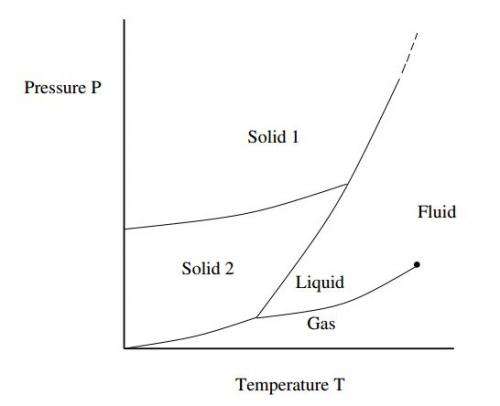A schematic experimental parameter space. Credit: Charles Radin, Notices of the American Mathematical Society.
(Phys.org) —Charles Radin a mathematical physicist with the University of Texas and one of his former student's David Aristoff, have built a 2D model material made of disks to represent atoms. In their article published in Notices of the American Mathematical Society, they suggest that their model shows that defining the difference between a solid and a liquid should be more a matter of measuring the way a material responds to shear, than looking at the way its atoms are arranged.
For most people, the difference between a solid and liquid is easy to discern—liquids move, they flow, they take the shape of whatever they are put in. Solids on the other hand, are rigid and don't slosh around. For physicists however, things are not quite so simple, especially since 1984 when Dan Shechtman discovered what are now known as quasicrystals (for which he won the Nobel Prize in Chemistry in 2011)—materials that appear rigid but upon closer inspection reveal a non-repeating pattern in the arrangement of their atoms. Thus, they're neither liquid nor solid according to the traditional definition (solids are supposed to be arranged in a crystal lattice), which muddles the very definition of the state of matter. Because of that, physicists and mathematicians have been looking for a new way to clearly differentiate between a solid and a liquid.
Radin and Aristoff suggest that measuring shear in a material is the way to go. In physics, shear is witnessed as a body part being deformed and can be expressed mathematically as the sidewise displacement between two points in parallel planes divided by the distance between those planes. In building their model, they found that at low densities, materials show no response to shear, but as the atoms move closer to one another and eventually become densely packed together, they do show shear, and also tend to result in expansion of the material. It's where it crosses over, the two say, that the definition of solid versus liquid resides.
Another team, this one in France, has another idea—they say matter can be defined as solid or liquid by measuring its viscosity, or ability to flow. They note that glass actually flows, very slowly of course, and so does diamond, though they note researchers would have to measure it over the course of the age of universe to see it flow due to Earth's gravity.
In either case, redefining what constitutes the different states of matter is important because without clear terminology, material descriptions can lose their meaning.
More information: Research paper PDF: www.ams.org/notices/201303/rnoti-p310.pdf
Journal information: Notices of the American Mathematical Society
© 2013 Phys.org

.jpg)



















